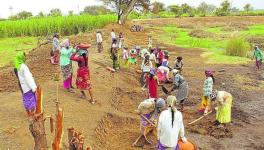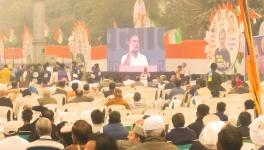The Curious Tale of Missing Migrant Voters in India

Unequal regional economic opportunities create sizeable internal migration within India, but the nation has yet not been able to solve the puzzle of properly account for their votes, writes Kashvi Verma.
—
As per the 2011 census data, 45.36 crore Indians, 37 percent of the population, are domestic migrants, i.e., they live in a place different from their residence of origin within the country.
Of them, 49 percent claim to have relocated for marriage and 10.2 percent for work, seeking better employment opportunities. The latter figure includes both blue- as well as white-collar workers, throwing up myriad challenges.
One of the important policy challenges is the anxiety over voter participation, which prompted the Election Commission to propose a unique remote voting mechanism through multi-constituency remote voting machines on December 29 last year.
Even though the system was eventually scrapped, the idea behind the move brings up pertinent questions about the push and pull factors that influence inter-state migration and what that means for the future of urban centres such as Delhi and Bengaluru.
An unsavoury data crunch
Much like the latest census survey, the need to conduct and conclude an All-India Survey on Migrant Workers launched in April 2021 cannot be overstated. Without the results of these mammoth exercises, we are left suspended in a void of ignorance about the sheer number of migrant workers, their household characteristics, socio-economic conditions and working conditions.
As per the 2011 census data, 45.36 crore Indians, 37 percent of the population, are domestic migrants, i.e., they live in a place different from their residence of origin within the country.
E-Shram portal is the first-ever national database of unorganised workers including migrant workers, construction workers, gig and platform workers, etc.
As of March 2023, 28.62 crore workers had been registered on the e-Shram portal, but this number only covers the unorganised sector and leaves out other categories which also fall under migrant workers.
The very definition of ‘migrant’ throws up a challenge, with different yet contemporaneous interpretations being used by the labour ministry, National Sample Survey Office (NSSO) and Registrar General.
Why migrate?
The vulnerability of migrant workers cannot and must not be seen through a myopic lens. Unemployment, underdevelopment, unfavourable government policies and other factors in the home state are larger structural problems that force people to leave behind their family, land, assets, etc., and move to cities with more lucrative opportunities.
Nearly 26 percent of Kerala’s workforce, for instance, is comprised of migrants. This figure is expected to touch 60 lakh by 2030, i.e., a sixth of the state’s population, as per a study published by the Kerala State Planning Board in 2021.
Perhaps much of the driving force behind this influx can be attributed to the disparity in wages fixed by state governments under the provisions of the Minimum Wages Act, 1948.
Reserve Bank of India data shows that in the financial year 2019–20, the average daily wage rate for male non-agriculture labour was ₹670 in Kerala while it was ₹271 in Uttar Pradesh and ₹267 in Bihar, two states with the largest outgoing migrant demographic.
As per the Economic Survey of Delhi 2022–23 published by the government of Delhi in March this year, there was a difference of over 200 percentage points between the growth in residential population and that contributed by migrants in the national capital in 2021 alone, standing at 1.01 lakh and 2.83 lakh respectively.
It must also be noted that this was the second year marred by the Covid pandemic, when hoards of migrant workers who had undertaken often-fatal journeys back to their native villages were beginning to trickle back to big cities in yet another desperate attempt to make a living.
Beginning in 2020 (the first Covid year), a drastic fall in the annual birth rate accompanied by a hike in the death rate meant that Delhi’s natural population growth slowed down for the first time in nearly two decades. The Civil Registration System computed the relative difference for 2019–21 to be 5.22 per thousand and 0.99 per thousand respectively.
Xenophobia, class bias and politicisation
The reverse flow of labour, however, was not limited to Delhi— and neither was the xenophobia that invariably tags along. Earlier this year, the chief minister of Goa pinned the blame for as much as 90 percent of the crimes committed in the state on migrant labourers from states such as UP and Bihar, going as far as to announce an upcoming online facility to increase compliance with the state administration’s policy of issuing labour cards to migrants.
E-Shram portal is the first-ever national database of unorganised workers including migrant workers, construction workers, gig and platform workers, etc.
The labour card regime is believed to improve access of local law enforcement agencies to databases on migrant labour. Needless to say, such measures reek of an unmistakable class bias.
Even unprecedented rainfall and the resultant waterlogging can be a cause for raging fury against immigrants. Bangalore Urban registered a 162 percent increase in the volume of rain received last year, in the period leading up to September.
As the ‘Silicon Valley’ of India came to a standstill, with images of people taking to boats and tractors to commute to their workplaces going viral on social media, a parallel stream of opinion came to inform public discourse surrounding the issue.
As opposed to holding the administration accountable for the gaping (pot)holes in the appalling state of city planning, many locals likened the very source of the problem to unchecked construction and encroachments which cause over-cementing, blocking the flow of urban runoff in the event of torrential downpours— attributable, of course, to the city’s ever-expanding migrant numbers.
Ironical as it may be, some of the worst sufferers of the crisis were poor migrants putting up in makeshift dwellings in overcrowded slums. These include people not just from other states but also from less prosperous parts of Karnataka itself, including Bagalkot, Bijapur, Kalaburgi and Yadgir, who build the towering apartments and swanky corporate offices they will never have access to.
Both slums and skyscrapers house migrants— who now constitute more than 50 percent of Bengaluru’s population— but of two entirely different worlds. A member of legislative assembly (MLA) from Chickpet has put a new spin on the situation by appealing to all sections of the electorate, promising better roads, more drainage pipes and housing for the urban poor ahead of the assembly elections.
The very definition of ‘migrant’ throws up a challenge, with different yet contemporaneous interpretations being used by the labour ministry, National Sample Survey Office (NSSO) and Registrar General.
Others continue to instigate natives for political gains. The Shiv Sena’s clarion call of ‘Mumbai for Mumbaikars’ and the Haryana Bharatiya Janata Party’s attempt to institute 75 percent domicile quota in the private sector are but two illustrations.
More to it
Upon revision and with effect from April 2022, as notified by the Ministry of Rural Development, Kerala saw an increase of almost 7 percent in the Mahatma Gandhi National Rural Employment Guarantee Act, 2005 (MGNREGA) wage rate for unskilled manual labour.
The absolute figure stands at a meagre ₹311 in a state that has consistently performed well on all parameters of human development, drawing a sizable migrant population.
Moreover, the Union owes states ₹6,366 crore in pending dues for wage component as on August 1, 2023. Not only do these liabilities need to be met, but the wage rates must also be at par with a better standard of living. As per the NCRB report, daily wage earners accounted for a quarter of all deaths by suicide in India in 2021.
Domestic migrants also lose out on being able to vote in elections, having been enrolled in their home state but residing elsewhere in the country. Rukmini S., in her seminal contribution to data journalism entitled Whole Numbers and Half Truths: What Data Can and Cannot Tell Us about Modern India, also makes a case that internal migration is the single biggest factor that contributes to low voter turnout.
Contrary to popular belief, it is not apathy (or lack thereof) that dictates people’s voting behaviour. Nor is apathy a result of affluence. Hyderabad registered the lowest turnout in the 2019 Lok Sabha polls but nearly one-third of the people in the city are below the poverty line. The wealthiest constituencies do not necessarily have the lowest rates of turnout either.
It is also worth noting that UP and Bihar had among the lowest voter turnout rates at 59.2 percent and 57.3 percent respectively. In Banda district of Uttar Pradesh, turnout in polling stations with over 25 percent out-migrants was three percentage points lower than the average.
It is also worth noting that UP and Bihar had among the lowest voter turnout rates at 59.2 percent and 57.3 percent respectively.
Again, class plays a role. Those who cannot afford to stay back find themselves in a sticky situation— devoid of the avenue to exercise the most elemental democratic right to representation, regardless of how politically conscious they may or may not be.
As Rukmini writes, “[M]issing voters are more likely those forced to miss out, rather than those choosing to.” If the numbers tell us anything, it is that widely held perceptions are often based on not much more than hearsay.
Conclusion
There is a dire need to bridge the gap between what is and what ought to be. The migrant crisis was not limited to Covid; the pandemic merely exacerbated it while bringing it to the centre stage.
Perhaps it is high time for the Union government to bring in a comprehensive policy on internal migration that mandates a nationwide database, locates challenges in allied sectors such as housing and social security, and informs welfare schemes targeted at a fast-growing demography on the move.
Kashvi Verma is a postgraduate student of politics and international relations at Jawaharlal Nehru University, New Delhi.
Get the latest reports & analysis with people's perspective on Protests, movements & deep analytical videos, discussions of the current affairs in your Telegram app. Subscribe to NewsClick's Telegram channel & get Real-Time updates on stories, as they get published on our website.























